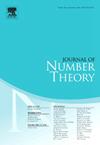The counting function for Elkies primes
IF 0.6
3区 数学
Q3 MATHEMATICS
引用次数: 0
Abstract
Let E be an elliptic curve over a finite field where q is a prime power. The Schoof–Elkies–Atkin (SEA) algorithm is a standard method for counting the number of -points on E. The asymptotic complexity of the SEA algorithm depends on the distribution of the so-called Elkies primes.
Assuming GRH, we prove that the least Elkies prime is bounded by when . Previously, Satoh and Galbraith established an upper bound of . Let denote the number of Elkies primes less than X. Assuming GRH, we also show
Elkies素数的计数函数
设E是有限域Fq上的椭圆曲线,其中q是素数幂。SEA (school - Elkies - atkin)算法是计算e上fq点数量的标准方法。SEA算法的渐近复杂性取决于所谓的Elkies素数的分布。假设GRH,我们证明了当q≥109时,最小Elkies素数以(2log (4q)2为界。在此之前,Satoh和Galbraith建立了O((log ln q)2+ε)的上界。设NE(X)表示小于X的Elkies素数的个数。假设GRH,我们也可以得到NE(X)=π(X)2+O(X(log (qX)2log (X))。
本文章由计算机程序翻译,如有差异,请以英文原文为准。
求助全文
约1分钟内获得全文
求助全文
来源期刊

Journal of Number Theory
数学-数学
CiteScore
1.30
自引率
14.30%
发文量
122
审稿时长
16 weeks
期刊介绍:
The Journal of Number Theory (JNT) features selected research articles that represent the broad spectrum of interest in contemporary number theory and allied areas. A valuable resource for mathematicians, the journal provides an international forum for the publication of original research in this field.
The Journal of Number Theory is encouraging submissions of quality, long articles where most or all of the technical details are included. The journal now considers and welcomes also papers in Computational Number Theory.
Starting in May 2019, JNT will have a new format with 3 sections:
JNT Prime targets (possibly very long with complete proofs) high impact papers. Articles published in this section will be granted 1 year promotional open access.
JNT General Section is for shorter papers. We particularly encourage submission from junior researchers. Every attempt will be made to expedite the review process for such submissions.
Computational JNT . This section aims to provide a forum to disseminate contributions which make significant use of computer calculations to derive novel number theoretic results. There will be an online repository where supplementary codes and data can be stored.
 求助内容:
求助内容: 应助结果提醒方式:
应助结果提醒方式:


